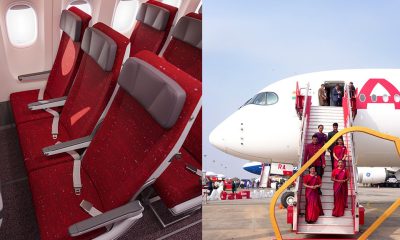Most Viewed ;
Man builds plane using Youtube, will fly it to his own wedding…!

How does one arrive at a wedding? Car? Carriage? How about homemade airplane?
That’s the plan for aviation geek Asmelash Zeferu. After an aborted attempt earlier this year, he is taking to the skies in K-570, his handcrafted light aeroplane. On November 28 the intrepid Ethiopian will fire his engine at an airstrip near Addis Ababa, and if all goes well, marry his fiance Seble Bekele the moment he lands. What makes it truly remarkable? The fact that Zeferu has never, ever flown before. Back with a bang
The Ethiopian’s second attempt comes five months after he first taxied to a runway 40 kilometers from the capital. That time a broken propeller — sculpted from laminated wood — scuppered his chances, but now he’s back and more confident than ever.
His engine has been upgraded to a model salvaged from a Volkswagen Transporter, doubling his power to 78 horsepower. Moreover, he’s sought professional advice to help him in the air.
Captain Solomon Gizaw of Abyssinia Flight Services and Captain Abera Lemi of the National Aviation College both confirmed to CNN that they had been helping out the budding pilot. Their mentorship sits alongside that of Rene Bubberman, chairman of the NVAV, the Dutch Experimental Aircraft Association — part of an international cohort backing Zeferu’s endeavor.
It’s been a long and remarkable journey, and for the Ethiopian a successful flight will be a moment over 10 years in the making. Zeferu, 35, says that ever since childhood he’d wanted to become a pilot. He was on the right track, but when the time came, Zeferu was denied for the most arbitrary of reasons. Leaving Alemaya University with a Bachelor’s degree in Public Health, he tried to enroll at the Dire Dawa branch of the Ethiopian Airlines Aviation Academy.
“I couldn’t fulfill the air school height requirements,” he explains. Zeferu was a centimeter too short. Despite this setback, Zeferu was unperturbed. “I decided to build my own aircraft if I couldn’t be a pilot,” he reasons, “then I’d be able to fly high in the sky.”
The first stage of his labor of love lasted 10 years. Aviation manuals and YouTube tutorials were his guiding stars; every aspect of aircraft manufacture gradually imbibed in painstaking detail. When the time came, Zeferu opted to model his plane on one used by trainee pilots in the U.S. in the 1920s and 1930s.
Some items were salvaged, others bought second hand from the Merkato market in Addis Ababa. The 8.5 meter wing was crafted from timber imported from Australia, with each wooden panel hand-sculpted. But there was one element of the plane Zeferu could not imitate.
The design called for a Ford engine, but the amateur engineer “couldn’t get [it] cheap in Ethiopia,” settling instead for a four cylinder, 40 horsepower model stripped from a Volkswagen Beetle — since upgraded to a 78 behemoth at a cost of 12,000 Birr ($570). But after a year and seven months Zeferu had finished. Not bad for someone who had “never stepped onto an airplane,” never mind worked within the aviation industry.
Zeferu’s earlier disappointments are now behind him and he’s ready to complete the task at hand. In doing so he would take a seat among a pioneering group of amateur enthusiasts from the continent. Not all have been successful: Kenyan Gabriel Nderitu has attempted to take off 13 times, but like his dream, his plane has so far failed to fly. Nigerian student Mubarak Muhammed Abdullahi created his own helicopter in 2007 with parts stripped from, amongst other things, a Boeing 747. Abdullahi had more luck, and after lifting 2.1 meters off the ground went on to gain a TED Global Fellowship and an aircraft maintenance scholarship in the UK.
Zeferu has made some modifications after receiving advice from fellow flight enthusiast Rene Bubberman, chairman of the NVAV, the Dutch Experimental Aircraft Association. “We gave him some well-meant advice about his prop and especially about test flying,” says Bubberman. “[His project] deserves a lot of respect… [it] truly breathes the spirit of the early airplane pioneers and his enthusiasm is contagious.”
On November 28, Zeferu will return to the same air field and rev his newly-modified machine. Taking off at 90 mph, the dizzying height he will aim for is 10 meters — not unreasonable considering he has “no parachute or anything to protect me.”
Zeferu demurs about the achievement of getting off the ground — he has other concerns. “To fly an aircraft is not a big deal,” he explains. “The greatest danger will be in landing.” That will involve slowing the plane down from its cruising speed of 70 mph to 45 mph, then hoping the wheelbase — taken from a Suzuki motorcycle — holds out.
Asked how he has been able to train for this, Zeferu says YouTube flight simulators have been key.
If he does land safely, Zeferu will have overcome the most persistent obstacle in his quest for flight. Despite support from his family, he argues that “the biggest challenge in building my aircraft was the people around me… people calling me mad. People were asking ‘How can you build an aircraft in Ethiopia? In Africa?’”
He’s emphatic about his chances this time around: “I am very sure that I will fly.”
‘We have lift off…’
Touching the skies in his homemade airplane is only the first step for Zeferu. He hopes a flight school will accept him in the near future so he can train as a commercial pilot. However the long-term goal is to boldly go further still.
“My dream is to become an aerospace engineer at NASA,” he admits. “And I will be.”
Source : CNN
Liked it ..!?
Share with your friends and family

Airlines
These are the 5 oldest airlines Still Operating in the World
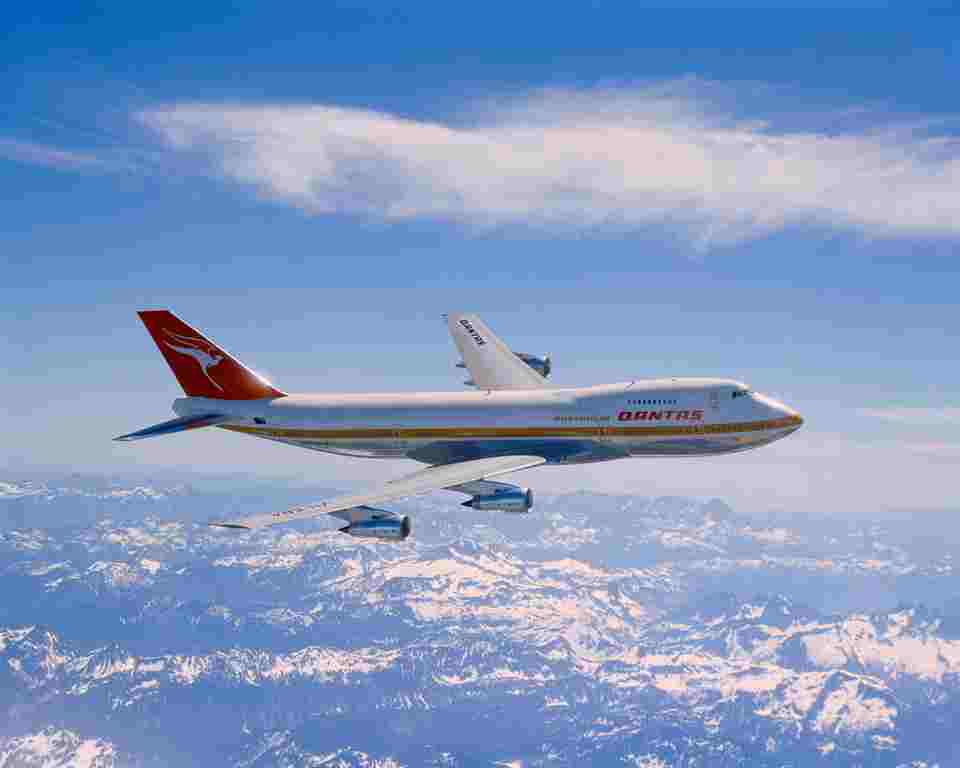
The history of aviation is an exciting adventure formed by the pioneering efforts of several individuals and organizations. The world’s oldest airlines, which have played a vital role in establishing the global travel sector, are among these trailblazers.
In this article, we will explore the five oldest airlines still in operation today, highlighting their remarkable journeys and enduring legacies in the world of aviation.
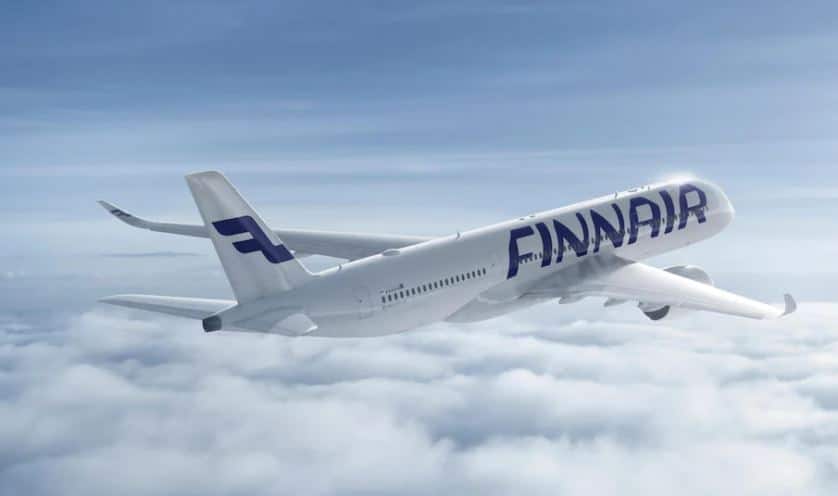
1. Finnair:
Founded: November 1, 1923
Headquarters: Vantaa, Finland
Primary Hub(s): Helsinki Airport
Fleet Size: 84
Destinations: 132
As a pioneer in European aviation, Finnair, founded in 1923, Marked its remarkable centennial milestone on November 1, 2023. Being among the oldest airlines in Europe, Finnair has witnessed many changes over the past 100 years, going from a small regional airline with few routes to a global leader in both air travel and hospitality.
Finnair’s adaptability has been demonstrated by its ability to quickly adjust to recent geopolitical developments and continue providing clients with exceptional service in its distinctive Nordic manner, even as it expands its services to North America and Southeast Asia.

2. Qantas:
Founded: November 16, 1920
Headquarters: Mascot, Sydney, Australia
Primary Hub(s): Brisbane Airport, Melbourne Airport, and Sydney Airport
Fleet Size: 130
Destinations: 85
Qantas is Australia’s flag carrier and the country’s and Oceania’s largest airline in terms of fleet size, overseas flights, and international destinations. It is the second-oldest airline still in operation.
Australian carrier Qantas holds its name among the oldest airlines in the world, with its foundations dating back to November 1920. Recently On November 16, 2020, QANTAS celebrated its remarkable centenary.
3. KLM Royal Dutuch Airlines
Founded: October 7, 1919
Headquarters: Amstelveen, North Holland, Netherlands
Primary Hub(s): Amstelveen, North Holland, Netherlands
Fleet Size: 116
Destinations: 145
KLM, officially known as KLM Royal Dutch Airlines, is the world’s oldest airline that is still in operation under its original name. On October 7, 1919, the company was founded. Four years ago, On 07 October 2019, KLM celebrated its remarkable centenary. As an airline from the beginning of the 20th century, it survived World War II and is currently part of the Air France-KLM company.
4. Aeroflot
Founded: February 3, 1923
Headquarters: Moscow, Russia
Primary Hub(s): Sheremetyevo International Airport
Fleet Size: 247
Destinations: 146
Aeroflot is Russia’s national carrier and largest airline. It is also Eastern Europe’s oldest airline, having been founded in early 1923. DOBOROLET, or The Russian Society for Voluntary Air Fleet, was the airline’s original name.
Aeroflot concentrated on foreign routes out of Moscow when the airline was separated into several enterprises. In celebration of its 100th anniversary in 2023, Russian airline Aeroflot (SU) recently began a series of retro-style flights, transporting customers on a nostalgic journey through time.
5. Avianca
Founded: December 5, 1919
Headquarters: Bogotá, Colombia
Primary Hub(s): El Dorado International Airport and San Óscar Arnulfo Romero International Airport (Avianca El Salvador)
Fleet Size: 102
Destinations: 114
On December 5, 2019, Avianca commemorated its 100th anniversary. The airline was founded in late 1919, according to its history. After acquiring a number of airlines in nearby nations, Avianca has grown to become one of Latin America’s biggest airline groups, with a fleet of over 130 aircraft and a network of subsidiaries covering almost the entire continent.
Aviation
World’s Top 21 riskiest Travel Destinations – U.S. State Department’s Level 4 Advisories”

The US government provides travel advisories to warn its citizens about the safety and security circumstances in numerous places across the world. These recommendations are intended to assist travelers in making informed decisions and minimizing risks while abroad.
While many countries are typically safe to visit, the US Department of State advises exercising caution or avoiding travel altogether owing to a variety of concerns such as political instability, terrorism, and natural disasters.
Travel advisory levels are released by the U.S. State Department for over 200 countries worldwide. These levels are updated regularly depending on a range of risk factors, including health, terrorism, and civil unrest. Level 1 travel advisories advise taking standard precautions, while Level 4 advisories advise not going there.
As of October 23, over 10% of countries—21 in total—had a Level 4: “Do Not Travel” advice. The State Department states that in Level 4 countries, the United States government may have “very limited ability” to take action if travelers’ security or safety is in risk.
Places With a Level 4 Travel Advisory
Afghanistan: According to the State Department, the Central Asian nation is dealing with “armed conflict, civil unrest, crime, terrorism, and kidnapping.”
Burkina Faso: This West African country is plagued by crime, terrorism, and kidnapping. With little to no notice, schools, restaurants, and hotels may become targets of terrorist strikes.
Myanmar (formerly known as Burma): The main barriers to visiting this Southeast Asian nation are civil chaos and armed conflict.
Gaza: Due to the current conflict, US officials advise visitors to Israel, the West Bank, and Gaza to either postpone their plans or stay away.
Iran: All visitors are at danger for kidnapping and unjust detentions, but Americans are particularly vulnerable to “arbitrary arrest and detention.”
Iraq: The State Department bases its Level 4 designation on “terrorism, kidnapping, armed conflict civil unrest.”
Libya: Conflict between armed groups in Libya’s East and West has plagued the country since the fall of its dictatorship over a decade ago.
North Korea: is home to one of the longest-running dynastic dictatorships in history, and US passports are not valid for travel “to, in, or through” this nation.
Russia: The invasion of Ukraine, arbitrary law enforcement, and intimidation of American citizens by Russian government officials are among the factors that led to the country’s Level 4 travel recommendation.
South Sudan: Weapon assault, kidnapping, and crime are the main risk factors, with violent crime being widespread in the nation.
Sudan: Due to the continued turmoil in the nation, the United States withdrew its embassy from Khartoum in April 2023 and blocked its airspace.
Yemen: Yemen has six of the nine risk categories listed by the State Department: landmines, terrorism, civil instability, health hazards, and kidnapping.
Malawi: Level 2
The Department of State is warning visitors to Malawi to travel with extra caution in light of recent criminal activity and civil upheaval.
Bangladesh: Level 2
US residents who are in Bangladesh or intend to travel there should be especially careful because of the country’s high crime rate, terrorist attacks.
Saba: Level 1
The most recent alert states that visitors to Saba should take standard safety precautions.
Aerospace
A Peek Inside BOEING 777X Test Flight at Paris Airshow.

Have you ever wondered, How aircraft undergo the process of earning final approval certificates from the FAA or EASA for passenger flight operations after testing?
Let’s have a look at it in the article below. Before building a physical model, the aircraft undergoes extensive design and material selection. As well as testing to determine its requirements and viability.
Jetline Marvel received permission to visit the inaugural Boeing 777-9 at Paris Airshow 2023. Granting a unique opportunity to glimpse the typically undisclosed aspects of the aerospace industry..
Boeing redesigned the Boeing 777x and B737. Giving them a more contemporary appearance, more spacious cabin, and more sophisticated amenities than the models that came before.

Take into consideration that the aircraft has an even larger engine to increase its speed and carrying capacity. The massive fan is only marginally smaller than the fuselage of a Boeing 737, with a diameter of 128 inches. The GE90-115B held the title of the world’s largest jet engine. Until the introduction of the even larger GE9X for the 777X. Although the engine has a diameter of 134 inches, it does not have the same thrust as the GE90.
Safety in the Skies: How Boeing Ensures Airworthiness Through Testing
Boeing’s 777X test planes, Including the 777-9 variant, feature a range of instruments and systems tailored for flight testing and validation.
These test aircraft assess the aircraft’s performance, safety, and compliance with regulatory requirements before it is ready for commercial service. Here are some of the key components and features typically found inside a Boeing 777X test plane.
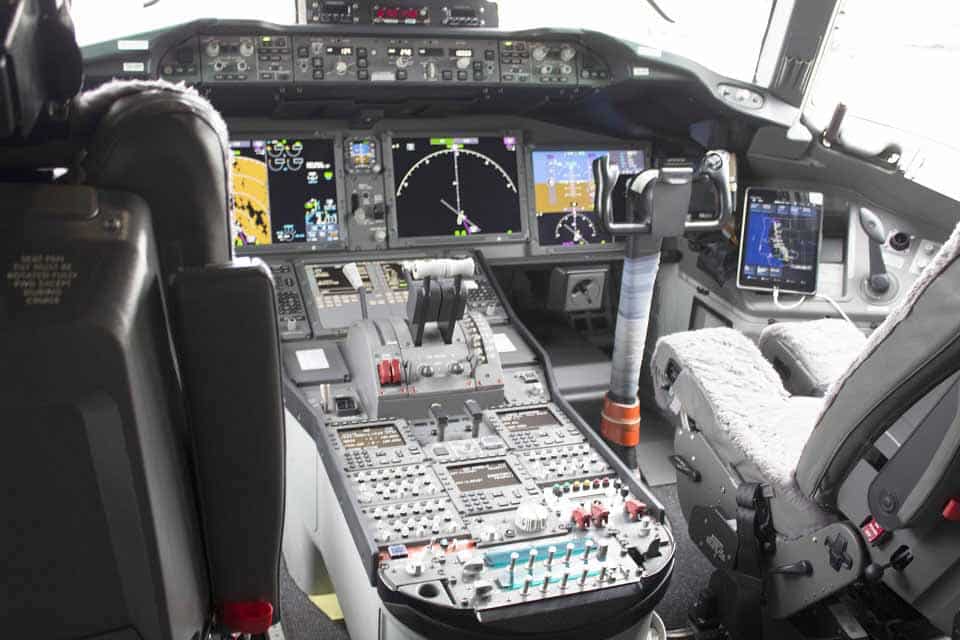
Flight Testing the Boeing 777X and B737: What Goes Onboard
Boeing 737-10 and Boeing 777 planes are experimental aircraft. Which are the forthcoming Boeing family aircraft that are currently in the testing process. The B737 Max has undergone minor fitness improvements. Boeing 777X is presently undergoing critical testing phases for its components, with an anticipated completion timeline of another 18 months.
Both aircraft arrived at the 2023 Paris Airshow. They permitted a few reporters to take a look inside the plane. It appears incredible to view the experimental airplane.
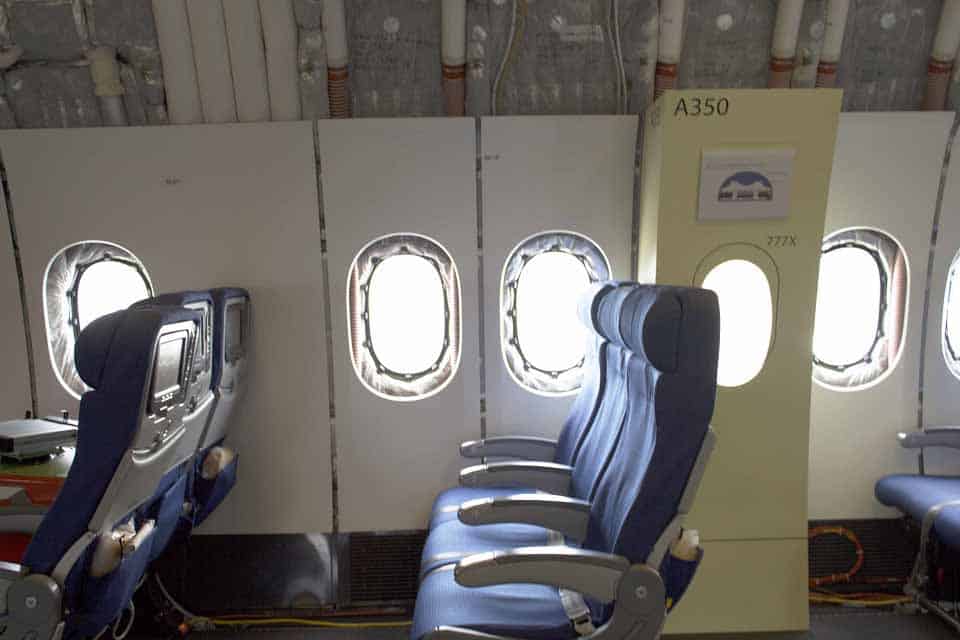
From Instruments to Ballast Tanks: The Tools of Aircraft Certification
The interior is designed to accommodate over 400 passengers in a standard two-class commercial layout. Resembles a vast, open space filled with numerous instrument racks.
Even the lateral walls, were devoid of wall finishings and fixtures. contributed to the overall work-in-progress feel of the space.
The large tanks you can see in this photo are at the back of the aircraft and serve a number of important functions for it to understand its own motion.
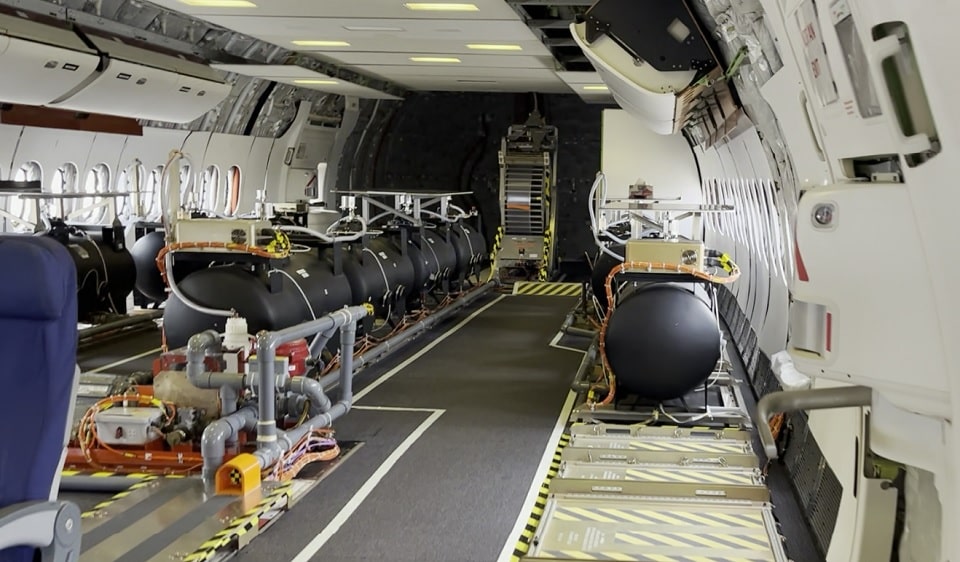
To achieve the required balance when the center of gravity of an aircraft or ship falls outside specified tolerances or the designated position, operators use ballast, which primarily consists of rubber or sand.
Engineers need to transfer water between the tanks to calculate the maximum weight balance of the aircraft under cruising conditions.
Difference between the Airbus A350 and B777x
Here is the difference between the Airbus A350 and B777x fuselage size which is quite bigger than A350 aircraft and the windows are slightly larger as well.
The cockpit boasts a modern design and incorporates cutting-edge avionics and engine features, elevating the aircraft’s capabilities.
In the aircraft, there are seats in the middle and on the right side, all of which come with soundproof covers. One of the middle seats also has a sensor installed. The left and right sides of the cabin have designated walking areas.
The difference between the Airbus A350 and B777x can be found in this article.

Furthermore, if you continue moving to the rear, you will notice some of the tanks that will be filled with water based on their weight
On the right side, we can see one of the engineers can sit and monitor the sensors and outside views. Most of the seats in the airplane are in the middle, where computers and sensor panels are arranged along with all the wires and sensors.
according to the weight load balance during the flight test mode. Internally coupled with pipers and pressure tanks, the tanks can instantaneously flow water within each other.

As we move back, we can see one of the controllers, which is usually used to manage the water lines.
At the back end, we can see the fuselage encased and insulated with soundproof materials, which works as a shield for the aircraft fuselage.
There are approximately four tanks on each side of the row, with around twelve tanks at the back end. We can see outside from the plane’s window and door.
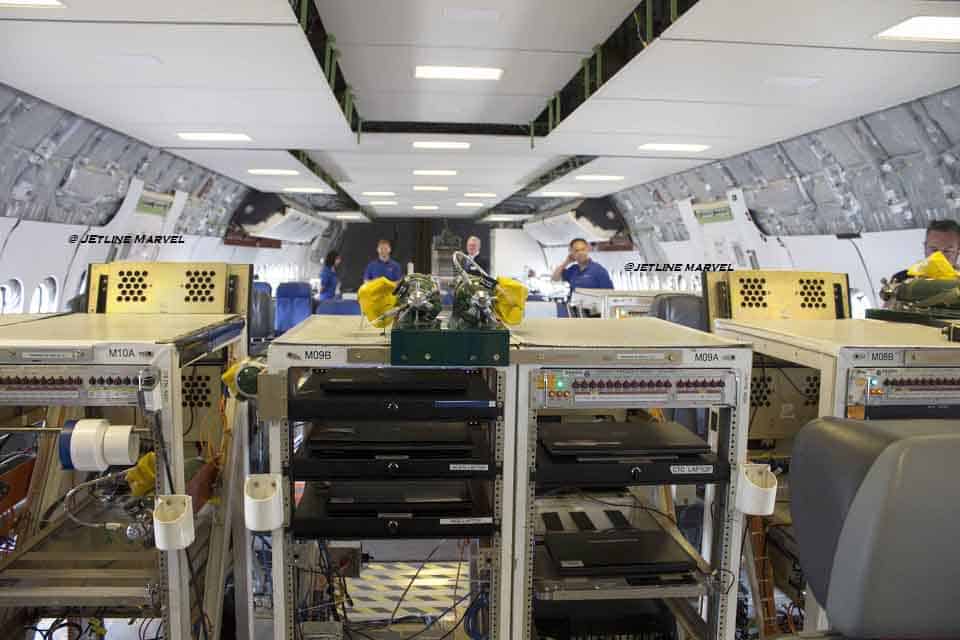
More computers and sensor monitoring chambers appear as we proceed. Engineers’ tasks are critical since they ensure that each test phase is completed. Some of the other journalists are shooting pictures inside the plane.
The aircraft looks impressive even prior to the installation of its seats. Understanding the variations in the aircraft’s data is made possible by the fact that the majority of the sensors are connected to different parts of the aircraft.
Furthermore, the aircraft is being equipped with the following types of instruments and equipment:
- Flight Test Equipment: Test planes have special tools and sensors to gather data about how well the aircraft works. They look at things like how it flies, its technology, and how strong it is.
- Controlling the Aircraft: They check if the systems that control the plane, like the fly-by-wire system, work the right way and are safe.
- Measuring Stress and Load: Sensors are put in different parts of the plane to see how much stress and pressure it can handle during the tests.
- Engineers on Board: Engineers are on the plane to keep an eye on everything, collect data, and make decisions during the tests.
- Computer Programs: They use special computer programs to study the data from the tests. This helps them see how well the plane is doing and what they can make better.
- Special Tools: Sometimes, they use special equipment, like tanks filled with weights, to copy different conditions during the tests.
- Safety First: Safety is a big deal, with backup plans and systems to keep the test crew and the plane safe.
- Like a Prototype: The test plane is like a prototype or an early version of the plane, so it might not have all the fancy features and systems of the final passenger plane.
Please share your thoughts on this article in the comments section. We would also be interested in hearing about any suggestions you may have for future aviation-related articles.


















